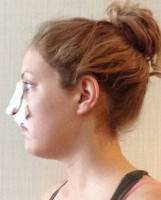Nose Job To Remove Bulbous Tip
A bulbous tip can be caused by a combination of things: too much tip cartilage, tip cartilage that is in the wrong position, and tip cartilage that is too splayed apart.
A careful analysis by an experienced nose job surgeon can help determine which problems a patient might be experiencing.
The correction then is determined by the cause. A bulbous tip can be improved through both an open and closed rhinoplasty approach. Additionally, excess tissue at the tip may be due to extra fat in the skin of the nasal tip.
Defatting of the tip is often necessary to bring out more contour and precision in the shape of the tip. Patients of color can often have this issue with their noses. Patients with thick, oily nasal skin may not be able to reduce the tip as much.
In fact, they may need extensive tip grafting to show a more contoured and precise tip shape. Seek the counsel of a surgeon with experience in bulbous nose job to determine the actual issues with your nose and they can help you determine the best course of action. (Manish H. Shah, MD, FACS, Denver Plastic Surgeon)
Usually a combination of things is done
A bulbous tip which is caused by enlarged cartilage is best improved by a combination of removing some cartilage and using suture techniques to create a better shape.
Sometimes a nasal tip looks wide because it lacks projection and placing a cartilage graft can both improve the projection and create a tip that looks more narrow. Sometimes the tip skin is thick, and this can be carefully thinned down to help the overall shape.
The bottom line is that many things can be done to improve the nasal tip, but it varies from nose to nose. The important thing is that you select a surgeon skilled in bulbous nose job to properly evaluate your nose and tell you what can be done. (Andrew Miller, MD, Edison Facial Plastic Surgeon)
How is a bulbous tip reduced?
This is a great but difficult question to ask. Generally when approaching the bulbous tip the vast majority of cases are treated by reducing the cartilage structures that give the tip support and definition. This can be performed by literally cutting the cartilages or by shaping them with stitches or other pieces of cartilage. However the tip is not just made of cartilage, it is also covered by layers of fat, muscle and skin,
You must look at this as a physical structure that is constructed of multiple components. It would be similar to seeing a bulging wall: is it the drywall, insulation or studs? Depending on the relative contributions of each of these layers, surgery is directed to the primary problem. For example, a condition called rhinophyma (commonly referred to as drinker’s nose) can cause the tip of the skin to be big and bulbous. The correction can require shaving down the layers of the skin, Hope this helps! (Otto Joseph Placik, MD, Chicago Plastic Surgeon)
Correcting a Bulbous Tip with nose job
The appearance of a “bulbous tip” most commonly arises from the shape of the underlying cartilages. If this is the case, the lower lateral cartilages (tip cartilages) can be trimmed and reshaped either with sutures or with grafts to relieve the excess curvature.
Sometimes, increasing the amount of tip projection makes the nostril sidewalls straighter and can help alleviate bulbousness Thick skin is an additional factor that can contribute to a bulbous tip. Thinning the undersurface of the skin is dangerous maneuver and can damage the blood supply. (C. Spencer Cochran, MD, Dallas Facial Plastic Surgeon)
Usually, nose tissue is not removed but reshaped
Removing tissue from the tip of the nose for a bulbous tip is actually a risky maneuver. This can devascularize the tip and lead to skin death at the tip of the nose.
Most of the time, cartilage reshaping can do wonders to narrow the tip even in the Asian nose. Many believe in the surgical community, that the nasal tip of the ethnic nose is mostly fat and thick skin. This is true to an extent but with proper shaping of the cartilage siginificant changes can be made to the tip and the bulbous tip especially. The only way to know if to have us look at it closely and examined. Open techniques are also a more accurate way to shape the nose. (Philip Young, MD, Bellevue Facial Plastic Surgeon)
The bulbous tip usually represents an enlargement of the underlying cartilages. When reshaping a nose, it is important to evaluate the entire nose to produce a well balanced outcome. As the cartilages are trimmed and reshaped, the overlying skin redrapes and conforms to the new shape. Think of a nose as a tent: the skin is the canvas of the tent, and the cartilages are the poles and structure.
As the poles are trimmed, shortened, or moved, the canvas adjusts to the new structure. (Ricardo Izquierdo, MD, Oak Brook Plastic Surgeon)
Usually the cause is too much cartilage in the tip or the wrong shape of the cartilage. It can be too thick skin and tissue above the cartilage. Best to se an experienced rhinoplasty surgeon for an evaluation. (Toby Mayer, MD, Beverly Hills Facial Plastic Surgeon)
Fixing the bulbous tip
A bulbous nasal tip has much more to do with how the tip relates to the rest of the nose than just removing and shaping cartilage. I often see patients who still complain of having a bulbous tip after a rhinoplasty by another surgeon and the tip has had too much cartilage removed. A bulbous tip may be that way because the tip cartilage is too broad or separated too much, but it often it is not.
A tip looks bulbous when the light that hits the tip forms a shadow at the lateral aspect of the tip so that it takes the appearance of a ball on the end of the nose. Making a tip blend into the rest of the nose and not look bulbous involved manipulating and often adding cartilage so that the shadow around the nose cannot persist and light blends into the lateral nose and prevents the appearance of a ball. In order to achieve this the tip cartilage is sometimes trimmed and is usually narrowed with suture.
Often tiny strips of cartilage are placed along the margin of the nose to prevent the shadow and sometimes the orientation of the cartilage is completely wrong and the entire cartilage needs to be dissected out of the surrounding tissue and reoriented to prevent the shadows and appearance of a ball.
In short it takes experience to diagnose the cause of the bulbous tip and perform the correct surgery to achieve the end result of an elegant nose with proper highlights and shadows. (Edward Buckingham, MD, Austin Facial Plastic Surgeon)
Bulbous tips are fixed by reshaping the underlying lower lateral cartilage
When considering the changes that would make a nose look better and function better, it is important to analyze the entire nose. It is important to bring the whole nose into harmony. While the bulbous nasal tip is most often changed by reshaping the lower lateral cartilages. These are made up of a medial crus which supports columella which is the part between the nostrils and the lateral crus which supports the dome of the tip of the nose. Often the top part is removed and the remainder is reshaped with sutures.
Sometimes it is helpful to reposition the lateral crus to reshape the alar margin, the rime of the nostril. But don’t forget that everything is in relationship with every this else and when you change one part of the nose it is critical to assess the effect it will have on other parts of the nose. It is also critical that you consult a qualified Board Certified Plastic Surgeon with a wealth of experience with rhinoplasties. See photos of before and after and talk to some of the surgeons previous patients. (Carl W. “Rick” Lentz III, MD, Orlando Plastic Surgeon)
Tip shape is an important part of rhinoplasty
Tip shape is a very important part of the rhinoplasty procedure. The concept of just how the tip is shaped and improved during the procedure can be hard to understand, and the American Society of Plastic Surgeons has a video on their site that helps describe the process. In rhinoplasty the skin of the nose is not altered, only the support underneath which defines the shape. The supporting cartilages and bone are modified so that the skin will form itself around these changes and establish the new nasal shape.The capacity or potential for change in any nose depends on the strength of the supporting tissue, and the ability of the skin to adapt, shrink, and fit the new shape. If the skin of the nose is quite thick we sometimes have to adjust our expectation as to how the result will be as definition may be lacking. If the skin is thin the support must be very precise because imperfections can easily show through.In order to best understand what may be possible with your “bulbous” tip, look for a surgeon who can use computer imaging to show you what might be possible for you, and to help you understand what you like and wish to change. (Peter E. Johnson, MD, Chicago Plastic Surgeon)
Rhinoplasty…The Bulbous Nasal Tip
The problem that is causing the bulbous tip needs to be diagnosed so that the proper surgical treatment can be carried out to correct it. Usually a bulbous tip is due to excess lower lateral cartilage or misshaped cartilages. It is usually corrected by delivering the lower lateral nasal cartilages (that make up the lower 1/3 of the nose), and removing the excess.
Sutures are frequently used to either reshape the cartilages, or to narrow the distance between them. Occaisionally cartilage grafts are created from the patient’s own nasal septal cartilage, and placed in the tip to create definition. Each nose is different; no two rhinoplasties are exactly the same. Choose your rhinoplasty surgeon most carefully, as your nose is difficult to hide there in the middle of your face. (Michael A. Persky, MD, Encino Facial Plastic Surgeon)
Fixing bulbous nose tip depends on anatomy
A bulbous tip usually comes from the shape of the underlying tip cartilage. This cartilage may sometimes be reshaped. The overlying skin then adapts to the new supporting structure underneath. It is important to realize the limits in treating the bulbous tip. The most important thing to remember is that these very cartilages are doing a big job, holding a portion of the nasal airway open.
So, the aesthetic wishes must be balanced with the functional need. Those patients with thick skin may not be able to achieve as much refinement as they would like because the thick skin can mask a great deal to the refinement achieved in underlying cartilage.
Those patients with very thin skin may not be able to achieve as much refinement either because the amount of cartilage alteration may have to be limited; or else it might show through the skin. Each patient is different and a photo is needed to specifically address your concerns. (Phillip Langsdon, MD, Germantown Facial Plastic Surgeon)



